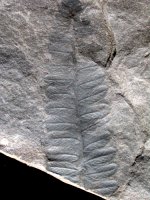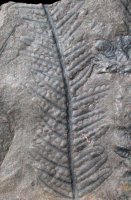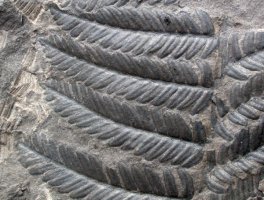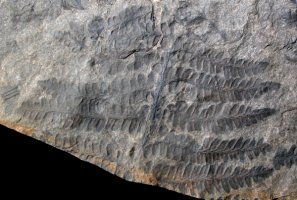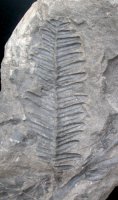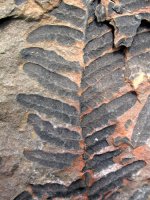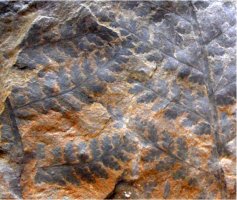(Real) ferns
There were two groups of plants with fernlike leaves: the real ferns (spore plants) and the seed ferns being gymnosperm plants. Thus seed ferns are not ferns at all! By far most of the real fern leaves belong to the genus Pecopteris and these are in most cases rather easily recognizable because of the fact that the leaflets are attached to the axis with their entire base. Look at the figure below. Most of the Pecopteris leaves come from large tree ferns, called Psaronius. These leaves are dominating the fossil record of Graissessac.

Terminology: A terminal part of a frond, like in the figure above, is called a pinna (plural: pinnae). A leaflet of such a pinna is called pinnule (plural: pinnules; also pinnula with plural pinnulae).
Pecopteris.
Characteristic for Pecopteris is the fact that the pinnules are
attached to the axis with the entire base. Furthermore they are pinnately
veined, i.e. they have a midvein with lateral veins.
It is often difficult and sometimes impossible to identify Pecopteris
leaves at species level. In Graissessac one species is clearly abundant:
Pecopteris polymorpha.
See also the photos at the bottom of this page.
Pecopteris polymorpha has relatively
larges pinnules, which are parallel-sided and often somewhat contracted at
the base. The pinnules are standing obliquely upward and close to each other
(often touching each other). They have a round apex and are often a bit convex.
The midvein is firm and sunken.
Pecopteris unita. The pinnules are
partly grown together. That's why the pinna looks like a leaf with a lobed
border. The lateral veins are arching upwards.
Pecopteris parvula. Small convex
pinnules with a length of 1.5 - 2 mm and a width of 0.7 - 1 mm.
Pecopteris arborescens. Pinnules
small (4 - 6 mm long, 1.5 mm wide), parallel-sided, close together, perpendicular
to the axis. Midvein sunken, clear. Lateral veins loose, rarely forked,
perpendicular to the midvein.
Pecopteris candolleana. Pinnules
strikingly narrow. They can be rather long (up to 10 mm). Not touching each
other and a bit decurrent. Lateral veins once forked, loose.
Pecopteris miltonii. Pinnules long
2 - 8 mm and wide 2 - 4 mm. Round apex. Nearly perpendicular to the axis.
Midvein nearly reaching the top of the pinnule and there forking. Upper side
of the leaf covered with hairs, making the veins unclear.
Renaultia and
Sphenopteris
The name Sphenopteris is used for fernlike leaves with lobed
or deeply incised leaves. Real ferns as well as seed ferns belong to this
genus, because this is a form genus. In such a genus species are lodged of
which the true nature (fern or seed fern) is not yet known. The species of
the genus Renaultia were formerly also called Sphenopteris,
until the moment the sporangia had been discovered. Then it was clear that
they were real ferns and the group was given its own name.
Renaultia chaerophylloides is the
most common species. The pinnules are small, flat and deeply incised. The
lobes of the pinnules are somewhat angular.
Sphenopteris decorpsii. It is not
known whether this plant is a fern or a seed fern. The pinnules resemble
the preceding plant but the plant is more robust.
We have found several other fossils belonging clearly to the genus
Sphenopteris, we couldn't identify them at species level.
Click on one of the photos below to proceed.
